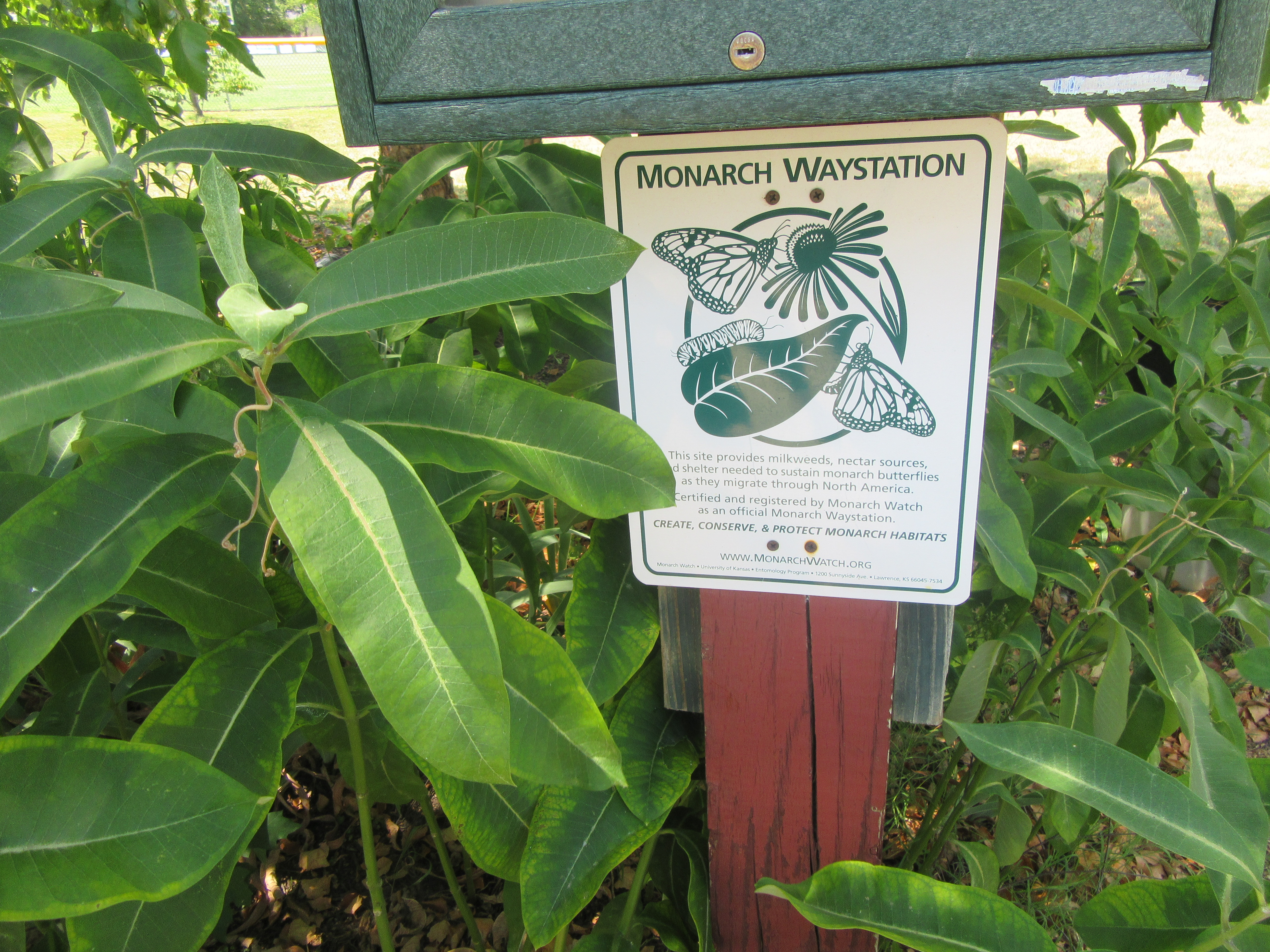Veneeta Anand has transformed her Alexandria front and back yards into native plant gardens that attract insects like this monarch butterfly.
As the thermometer hits the 90s and the heat index creeps up over 100 degrees Fahrenheit, leaves are drooping and yards are turning brown. It may be time to rethink the American lawn.
While a manicured, green lawn may be a cherished American ideal, grass has several drawbacks, from requiring mowing, water and fertilizer to providing little biodiversity and habitat value.
Water Is Precious
June was the fourth driest on record for the Washington region, states the Interstate Commission for the Potomac River Basin. Virginia Department of Environmental Quality (DEQ) reports “abnormally dry conditions … across approximately 98 percent of the Commonwealth.”
On June 24, Fairfax and 95 counties and towns were under a drought warning advisory, meaning that a “significant drought is imminent,” said DEQ. It may get worse. The U.S. Geological Survey website says that “climate change exacerbates droughts by making them more frequent, longer and more severe.”
Water is precious. Lawns consume around nine billion gallons of water a day, the National Wildlife Federation (NWF) points out. To stay green, a 10,000-square-foot lawn requires 10,000 gallons of water every summer, reports the U. S. Fish and Wildlife Service (FWS).
Lawn and turf grass are the largest crop in the Chesapeake Bay watershed. Grass is the biggest irrigated crop in the U.S., totaling over 40 million acres, three times more than corn, reported the journal Environmental Management.
 Volunteers and staff at the Hollin Hall Senior Center in Mount Vernon planted milkweed plants to support monarch butterflies. The center is an official monarch waystation.
Volunteers and staff at the Hollin Hall Senior Center in Mount Vernon planted milkweed plants to support monarch butterflies. The center is an official monarch waystation.
Lawns’ Downside
In addition to being water guzzlers, lawns can be 85 to 90 percent impervious, meaning that the water infiltration rate into the soil is low and stormwater flows off the surface instead of saturating the soil.
“Lawns have less than 10 percent of the water-absorbing capacity of natural woodlands, which contributes to suburban flooding,” states the NWF.
Polluted runoff from the land is the only growing source of pollution to the Potomac River, the Potomac Conservancy contends. Fairfax County studies show that in 2023, 83 percent of the county’s streams were in fair to very poor condition, largely because of stormwater runoff.
Lawn mowers and leaf blowers create air and noise pollution. Using a gasoline-powered lawn mower to cut grass for one hour is almost equivalent to the air pollution from a 100-mile automobile trip, says Science Daily. In 2020, lawn equipment released more than 68,000 tons of nitrous oxides, equal to the pollution from 30 million cars, and 30 million tons of carbon dioxide, the U.S. Environmental Protection Agency found.
If Not Lawns, What?
Approaches like natural or conservation landscaping offer multiple benefits, like cost savings, less maintenance and a healthier, more biodiverse environment. Conservation landscaping encourages native plants, those that naturally occur in a region and have evolved to survive in local conditions. With this evolutionary advantage, they have adapted natural defenses to local challenges like drought and pests. Non-native plants have few natural controls.
Native wildlife need the native plants with which they co-evolved. Wildlife like insects, birds and small mammals depend on those plants for food, cover and rearing young. Many insects are specialized to feed and reproduce only on certain native plants, called host plants. Birds need those insects to feed their young.
Over 40 percent of the world’s insect species face possible extinction according to a 2019 study in Biological Conservation. “Insects are the little things that run the world,” said the late entomologist Dr. E. O. Wilson. Without them, the food web would collapse.
As a monoculture, “Turf offers little or no wildlife habitat compared to the diversity of plants found in an existing forest,” says the Community Forestry Network.
“Lawns … have very little benefit for wildlife,” wrote Dr. Mark Hostetler, University of Florida.
Unlike grass which has shallow roots extending only one to two inches into the soil, most native plants have deeper root systems. Native plants can help prevent erosion and by reaching deeper into the soil, can also be more drought tolerant than invasive plants.
Betsy Martin Co-Director of the Audubon at Home program, Audubon Society of Northern Virginia, says, “Native plants come in all sizes and sorts, and can be suited to every garden situation and anybody's taste, whether informal or formal. Native plants are adapted to our Virginia soils and climate, and many are almost impervious to drought. That means that a homeowner can create a native garden that requires minimal watering and no fertilizer."
University of Delaware entomologist Douglas Tallamy challenges, “Everyone who owns land has a golden opportunity to enhance, rather than degrade, local ecosystems by including ecological function as a criterion when we choose plants.”
How to “De-lawn”
* Reduce grassy areas by expanding existing beds with native plants. Cover grass with a tarp, weed cloth or cardboard not treated with any harmful chemicals.
* Plant native, drought-tolerant plants. Avoid non-native plants.
* Install rain barrels. Reuse water.
* Mulch with leaves, grass clippings and pine needles to retain soil moisture. Leave the leaves in the fall.
* Mow high between 3.5 to 4 inches and let grass clippings return nutrients to the soil.
* Avoid pesticides, rodenticides and insecticides.
